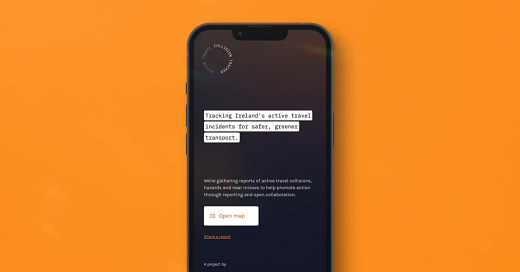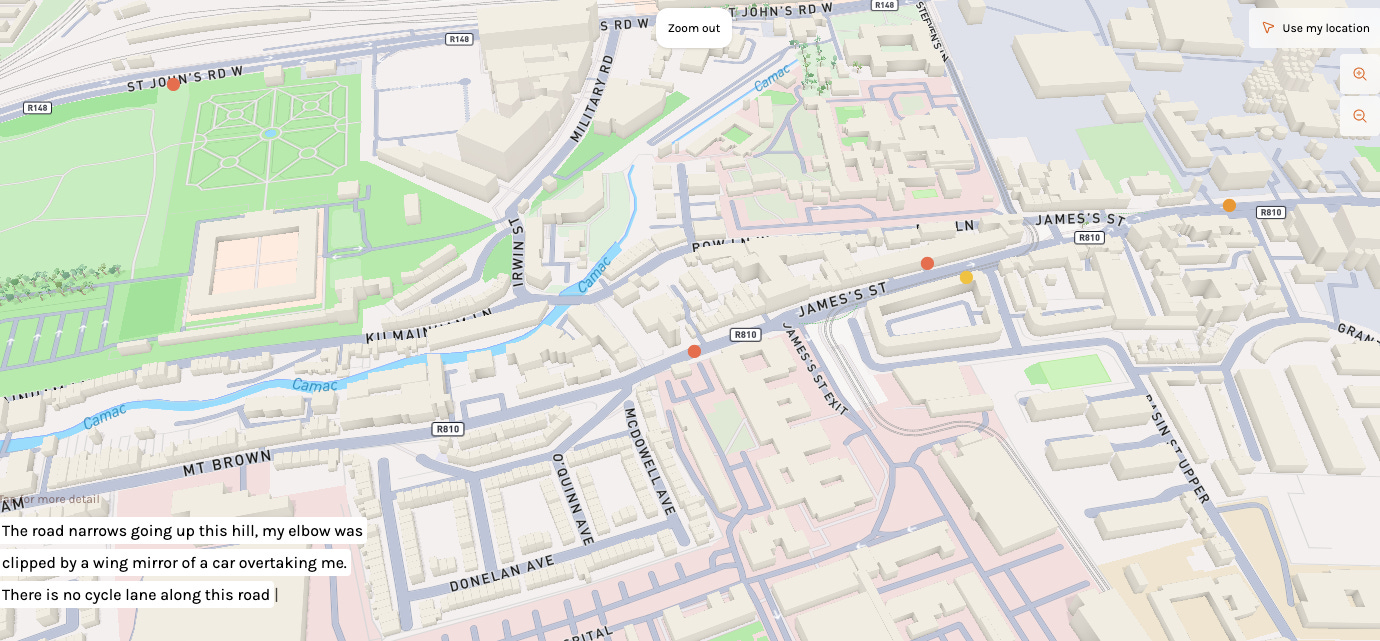Can a tool that tracks cycle collisions combat climate change?
Yes, thinks the brains behind Collision Tracker which launched this week and will be used by Dublin Inquirer, Irish Cycle and Tripe + Drisheen to build a better picture of cycle safety in Ireland.
The aim of Collision Tracker is straightforward: it’s a newly launched digital tool which allows cyclists across Ireland to report incidents of misses, near misses and collisions.
The mission, however, is both grand and urgent: to make our roads safer and in doing so to encourage more people to cycle in an effort to drive down carbon emissions, and with it increase the health of the nation.
“A shift to active travel and transit is critical if we are to consider Ireland's 2030 climate commitments realistic, especially in urban areas where transport accounts for a quarter of all emissions and where 80% of journeys could be theoretically be replaced by transit, cycling and other active modes,” said Brian Rogers or Orbiter who developed the Active Travel Collision Tracker.
Together with journalists from Dublin Inquirer and Irish Cycle.com, Tripe + Drisheen will be looking thru the data that users report, especially “for clusters, so we can report on danger spots and how they could be made safer, or trends and what they say about how to make the roads safer,” as Sam Tranum wrote in the Dublin Inquirer.
Likewise, “We also hope that local councillors, council staff, and others will be interested in the reports we’re gathering and put them to use to make the roads safer.”
Through the reports submitted to Collision Tracker, Brian Rogers from Orbiter, a climate action-focused product and design studio, says the goal is to get a much clearer picture, and more efficiently, so that local authorities and national agencies can address the hugely important question: how safe is cycling in Ireland? And, what can be done to make conditions safer?
Doubtless, that’s a question the cohort of Cork City Councillors who went on a NTA-funded cycle-study trip to Utrecht last month will have asked their counterparts in Holland, which has some of the highest active travel rates in Europe.
Data released from the Road Safety Authority (RSA) for 2023 revealed that of the 184 people killed on Irish roads - a 19% increase over 2022. Included in the total number of fatalities on Irish roads, eight were cyclists, three were on e-scooters and 44 were pedestrians.
Up until 2016, the RSA used to share data of collisions in an online map, but this practice has been discontinued.
So how does Collision Tracker work? Users identify the location of where the collision, or near collision, took place on a map of Ireland. From there you are asked a few more questions via a drop down menu to provide more context before submitting. While reported incidents are publicly viewable on Collision Tracker, information which would reveal the reporter is not.
Brian Rogers, the developer of Collision Tracker, thinks that the combination or reporting incidents and recording that data could play a role, no matter how smalll, in delivering improvements.
“There’s a lot of great progress being made in this area by advocates and local authorities across Ireland. I hope both groups can make use of the data to help support their work.”
As Sam Tranum of Dublin Inquirer wrote: “We hope our Active Travel Collision Tracker can play a role in gathering the data councils need to make the roads safer for all road users – especially the most vulnerable, like cyclists and pedestrians.
“Please use this tracker, and ask others to use it, and share it widely. The more data we can gather, the better.”
Over to you Cork.
Thanks to Brian Rogers, of Orbiter, who built the Active Travel Collision Tracker, and to Sam and the team at The Dublin Inquirer for including T+D.
If you have questions about the Active Travel Collision Tracker, they might be answered in the FAQs at the bottom of the home page. You can contact us at tripeanddrisheen@substack.com for more information or questions you may have.
A bike box goes up in Ballintemple, but Cork City Council says it must come down
The O’Regan family, who live on Maryville in Ballintemple, are a one-car family. They also have a cargo bike and a bike box out the front of the house to store the cargo bike, as well as wheelie bins, and the kids' bikes and scooters. So far, so suburban.






